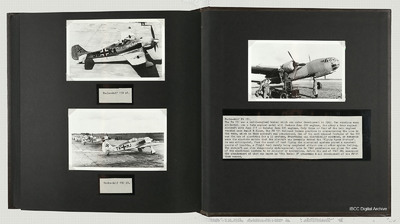Focke-Wulf 190
Title
Focke-Wulf 190
Focke-Wulf 191
Description
A Focke-Wulf 190 A1
A row of Focke-Wulf 191 A3s
A front side starboard view of the front half of a Focke-Wulf 191.
A row of Focke-Wulf 191 A3s
A front side starboard view of the front half of a Focke-Wulf 191.
Coverage
Language
Type
Format
Three b/w photographs on two album pages
Publisher
Rights
This content is available under a CC BY-NC 4.0 International license (Creative Commons Attribution-NonCommercial 4.0). It has been published ‘as is’ and may contain inaccuracies or culturally inappropriate references that do not necessarily reflect the official policy or position of the University of Lincoln or the International Bomber Command Centre. For more information, visit https://creativecommons.org/licenses/by-nc/4.0/ and https://ibccdigitalarchive.lincoln.ac.uk/omeka/legal.
Identifier
PThomasAF20060055
Transcription
[Photograph]
Focke-Wulf 190 A1.
[Photograph]
Focke-Wulf 190 A3.
[Page break]
[Photograph]
Focke-Wulf FW 191.
The Fw 191 was a multi-engined bomber which was under development in 1942. Two versions were projected, one a twin engined model with Junkers Jumo 222 engines, the other a four engined aircraft with Jumo 211 or Daimler Benz 605 engines. Only three or four of the twin engined version were built & flown. The FW 191 followed German practice in concentrating the crew in the nose, which in this aircraft was pressurised. One of the most unusual features of the 191 was the use of electrics for all systems. Everything was electrically operated, so numerous were the electric motors that the aircraft was promptly dubbed the ‘Flying Power Station’. As was anticipated, from the ouset [sic] of test flying the electrical systems proved a constant source of trouble, a flight test rarely being completed without one or other system failing. The aircraft was also dangerously under-powered. Late in 1942 permission was given for some of the electrical systems to be replaced by hydraulics. Before the end of 1943 RML announced the abandonment of what was known as ‘The Bomber B’ programme & all development of the FW191 then ceased.
Focke-Wulf 190 A1.
[Photograph]
Focke-Wulf 190 A3.
[Page break]
[Photograph]
Focke-Wulf FW 191.
The Fw 191 was a multi-engined bomber which was under development in 1942. Two versions were projected, one a twin engined model with Junkers Jumo 222 engines, the other a four engined aircraft with Jumo 211 or Daimler Benz 605 engines. Only three or four of the twin engined version were built & flown. The FW 191 followed German practice in concentrating the crew in the nose, which in this aircraft was pressurised. One of the most unusual features of the 191 was the use of electrics for all systems. Everything was electrically operated, so numerous were the electric motors that the aircraft was promptly dubbed the ‘Flying Power Station’. As was anticipated, from the ouset [sic] of test flying the electrical systems proved a constant source of trouble, a flight test rarely being completed without one or other system failing. The aircraft was also dangerously under-powered. Late in 1942 permission was given for some of the electrical systems to be replaced by hydraulics. Before the end of 1943 RML announced the abandonment of what was known as ‘The Bomber B’ programme & all development of the FW191 then ceased.
Collection
Citation
“Focke-Wulf 190,” IBCC Digital Archive, accessed November 8, 2024, https://ibccdigitalarchive.lincoln.ac.uk/omeka/collections/document/23190.
Item Relations
This item has no relations.

